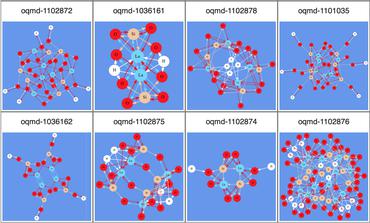Formation Energy
29 papers with code • 14 benchmarks • 8 datasets
On the QM9 dataset the numbers reported in the table are the mean absolute error in eV on the target variable U0 divided by U0's chemical accuracy, which is equal to 0.043.
Libraries
Use these libraries to find Formation Energy models and implementationsLatest papers with no code
Atomistic calculations of charged point defects at grain boundaries in SrTiO$_3$
We report calculated formation energies of oxygen vacancies on all the oxygen sites across boundaries between two misoriented grains, and we analyze and discuss the formation-energy values with respect to local charge densities at the vacant sites.
Simple prediction of immiscible metal alloying based on metastability analysis
It has been known that even though two elemental metals, $X$ and $Y$, are immiscible, they can form alloys on surfaces of other metal $Z$.
Interlayer Ferromagnetism and High-Temperature Quantum Anomalous Hall Effect in \textit{p}-Doped MnBi$_2$Te$_4$ Multilayers
The interlayer antiferromagnetic coupling hinders the observation of quantum anomalous Hall effect in magnetic topological insulator MnBi$_2$Te$_4$.
Computational discovery of new 2D materials using deep learning generative models
Two dimensional (2D) materials have emerged as promising functional materials with many applications such as semiconductors and photovoltaics because of their unique optoelectronic properties.
Oxygen vacancies in SrTiO$_{3}$ thin films at finite temperatures: A first-principles study
The present work demonstrates that for a realistic theoretical description of oxygen vacancies in oxide perovskite thin films is necessary to consider lattice thermal excitations, thus going beyond standard zero-temperature ab initio approaches.
Transferable Multi-level Attention Neural Network for Accurate Prediction of Quantum Chemistry Properties via Multi-task Learning
The development of efficient models for predicting specific properties through machine learning is of great importance for the innovation of chemistry and material science.
Learning formation energy of inorganic compounds using matrix variate deep Gaussian process
In this paper, we propose a deep Gaussian process based approach to develop an emulator for quantum calculations.
Steerable Wavelet Scattering for 3D Atomic Systems with Application to Li-Si Energy Prediction
Here this approach is extended for general steerable wavelets which are equivariant to translations and rotations, resulting in a sparse model of the target function.
Hierarchical modeling of molecular energies using a deep neural network
We introduce the Hierarchically Interacting Particle Neural Network (HIP-NN) to model molecular properties from datasets of quantum calculations.
Machine learning prediction errors better than DFT accuracy
We investigate the impact of choosing regressors and molecular representations for the construction of fast machine learning (ML) models of thirteen electronic ground-state properties of organic molecules.














 Materials Project
Materials Project
 MD17
MD17
 QM9
QM9
 OQMD v1.2
OQMD v1.2
 OQM9HK
OQM9HK
 WBM
WBM